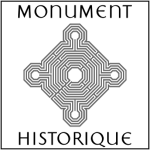Resident of the cross Méautis, 21 years old in 1944
 I worked in my parents’ farm, at a place called Cross capped and which now bears the name of the cross Méautis. The Germans did not occupy our farm but they came to ask supplies during the occupation. In 1943 I had to report to the STO, compulsory work service. I refused to go and so I stayed at my parents’ farm without ever leaving home, which did not bother me much because we had been bred away from the city.
I worked in my parents’ farm, at a place called Cross capped and which now bears the name of the cross Méautis. The Germans did not occupy our farm but they came to ask supplies during the occupation. In 1943 I had to report to the STO, compulsory work service. I refused to go and so I stayed at my parents’ farm without ever leaving home, which did not bother me much because we had been bred away from the city.
I have few memories of the night of June 5 to 6, 1944 except for the fact that there had been quite intense bombardments but we used to hear from time to time. By cons I remember the Battle of Carentan which made a terrible noise. During and after the Battle of Carentan civilian refugees arrived at our home in Cross capped a hundred maybe. There were among them very seriously injured. This continued all week. We lived with them from eating butter, bread I made myself on the farm next door to feed all these people! Three quarters of the refugees came from Carentan and went up by Holgate Street. However, there were people who came from other places. I remember one guy we never saw that came from Britain. We knew many of the refugees. They lived in common from our farm, fields or other places. There are among them who were afraid when they slept in the stables. We had a shelter in the garden to the right, near the piece of land next. Our shelter was at eye level and was covered with bushes with soil on top. But we did not think we would be bombed.
One day an airplane passed, I think it was a reconnaissance aircraft. He passed and repassed several times over the house. We made him signs to show that there were civilians. As the first bombs or shells burst everyone descended into the shelter, at least those who wanted to go. I did not go because I was not afraid.
The Americans first made a barrage, killing the Germans who were right in front of our firm position. They were positioned along the hedge. Then a second shot came to us, close to the shelter. A huge tree which was at the end of the garden was cut in half. That’s when there were injuries among the refugees home. Those who could get out of the shelter are returned home quickly through the garden.
There was a girl who was wounded in the head. It was me who went down to look for in the shelter. Her name was Paulette Noray a cousin of my wife. She had shrapnel in the head. The Americans have taken to their tents but they brought back between the planks, she did not survive. There were among the wounded Mr. Jacquet who was seriously injured during the bombing of Carentan. There was also a lady who gathered Valet shot in the thigh. I was right beside her when it happened.
It was the Americans who took them later. We saw the first Americans June 12, 1944 immediately after the liberation of Carentan.
On Saturday, June 10th a detachment of Germans with horses had come across the firm position. There was a German each tree but as I said already, they were dashed when the Americans made a barrage. We saw the German soldiers took stampede and towards the town of Méautis. At the entrance to the court a US soldier had installed a machine gun and firing at the Germans fleeing Carentan. He went down 5 or 6 Germans in one place. We were really released June 13 in the evening.
Contact with the Americans went well but we had other things on his mind because the house had burned between. We think it is the Germans who set fire because we discovered two German phosphorus shells in barns that had not exploded. It’s amazing, it’s a stroke of luck because there were lots of people in it. The house began to burn through the attic and the fire spread to the first floor and begin to attack the heavy beams of the floor. We waited in line with people carrying buckets of water and we managed to stop the fire like that. The roof, the attic and the first floor had burned completely!
I can still see the American truck that picked all the wounded. A second truck took with him all those who wanted to be evacuated. So my parents were transported to Fontenay. I remained in the house with a man of Carentan, Mr. Jack, who brought all his cows home. He was a friend of my father. We spent the night both in the house when, next night we were woken by a German who screamed “paperr, papeer” . We looked out the window and we saw a German who ran off!
I remember one thing that struck me particularly. Before that civilians are evacuated and just after the Germans were killed in the opposite field, I went to make a turn with a policeman who had taken refuge with us. He came from Britain. I unfortunately never knew his name and he never came to see us after the war. He wore his gun at him. When we passed near a German wounded we have seen the latter who wanted to take a gun that was in his reach. The officer quickly pulled out his pistol and shot the German soldier on the spot. He has not done a fold! I think if the policeman had not seen it we would come down!
It was the Americans who then picked up with trucks, the dead German soldiers. The Americans were then in the field opposite two large trenches in which they buried 40 cows.
I must admit I’ve never been afraid of the bombing or even Germans.
I have one anecdote that almost cost me my life. Indeed Sunday, June 11, 1944 I had to hitch our mare to go milk the cows because we had a lot at that time, when a German came requisition cart. I did not want to give him and the tone is mounted. The German began to put his hand on his gun when my father said “loose there!” While the German has commandeered the mare and we did not review …
Next testimony: Yvette Tesson







